| OCTOBER 2020 |
| Postponement or cancellation of a few Kabuki performances in October 2020 due to coronavirus (COVID-19)!!! |
|
6 shows in T˘ky˘ (Kabukiza, National Theatre), 1 in Nagoya (Misonoza), 1 in Yamaga (Yachiyoza), 1 in Nagoya (NTK Hall), 1 in ďsaka (Sh˘chikuza) and 1 tour (Classics Tour)!
|
| Kabukiza (T˘ky˘) |  |
| Dates | 2 ~ 27 October 2020 Jűgatsu ďkabuki October Grand Kabuki |
| 1st program | |
| 2nd program | |
| 3rd program | |
| 4th program |
Y˘kihi |
| Casting |
Living National Treasure Kataoka Nizaemon, Living National Treasure Band˘ Tamasabur˘, Nakamura Shikan, Nakamura Shichinosuke, Nakamura Kankur˘, Kataoka Takatar˘, Band˘ Yajűr˘, Nakamura Karoku, Ichikawa Komaz˘, Ichikawa Monnosuke, Matsumoto Kingo, Ichikawa Omez˘, Nakamura Matsue, Nakamura Hayato, Band˘ Shingo, Nakamura Fukunosuke, Nakamura Utanosuke, Ichikawa Otora, Nakamura Tamatar˘, Kataoka Matsunosuke |
| Comments |
Not the usual October Grand Kabuki at the Kabukiza but a 4-program Grand Kabuki in these times of COVID-19.
|
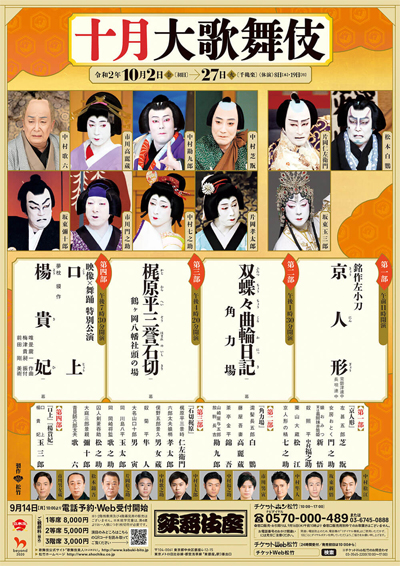 |
| Misonoza (Nagoya) |  |
| Dates | 3 ~ 18 October 2020 Kinshű Misonoza Kabuki Autumn Brocade Misonoza Kabuki |
||||||||||||||||||||||||||||||||
| Program |
Kane-ga-Misaki Kabuki no Mikata |
||||||||||||||||||||||||||||||||
| Casting |
Onoe Kikunosuke, Onoe Ukon, Nakamura Mantar˘, Onoe Kikuji |
||||||||||||||||||||||||||||||||
| Comments |
Due to the COVID-19 crisis, this is not the classic October kaomise programs in Nagoya. There are two programs, program A and program B, with the same contents but a different casting. Each program is staged either at 12:00 (matinÚe) or at 16:00 (evening):
|
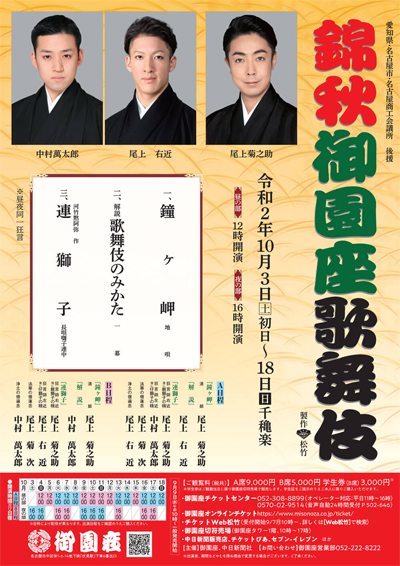 |
| National Theatre (T˘ky˘) |
| Dates | 4 ~ 27 October 2020 |
| 1st Program | |
| 2nd Program | |
| Casting |
Living National Treasure Onoe Kikugor˘, Nakamura Tokiz˘, Nakamura Baigyoku, Nakamura Kaishun, Nakamura Senjaku, Matsumoto K˘shir˘, Ichikawa Sadanji, Ichikawa Danz˘, Onoe Sh˘roku, Band˘ Hikosabur˘, Nakamura Baishi, Kataoka Kamez˘, Ichimura Manjir˘, Kawarasaki Gonjűr˘, Band˘ Kamez˘, ďtani Hirotar˘, Nakamura Kangyoku, Sawamura S˘nosuke, Nakamura Kamenoj˘, Ichimura Kitsutar˘, Onoe Ushinosuke |
| Comments |
The first Grand Kabuki performances at the National Theatre since the beginning of the COVID-19 crisis:
|
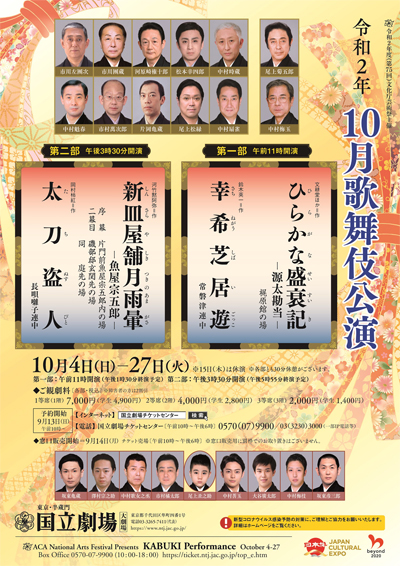 |
| Sh˘chikuza (ďsaka) |  |
| Dates | 15 ~ 18 October 2020 |
| Program |
Yomigaeru Meibamen GOEMON Sh˘ |
| Casting |
Kataoka Ainosuke, Nakamura Ganjir˘, Kamimura Kichiya, Nakamura Kazutar˘, Nakamura Tanenosuke, Imai Tsubasa |
| Comments |
A special COVID-19 program at the Sh˘chikuza starring Kataoka Ainosuke, which is a shortened version of the program version described below and which has been canceled. The Sh˘ in the newly-created title is an ideogram meaning excerpt, extract or abridgement. Phonetically it is also a pun with the English word "show". Yomigaeru Meibamen means revival of the best scenes. So we can say that they will perform a short best-of of "GOEMON". There is indeed a GOEMON show in ďsaka in October 2020. |
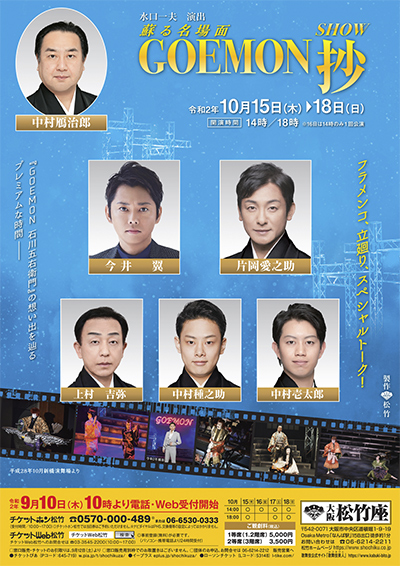 |
| Dates | Jűgatsu Hanagata Kabuki October Young Actors Kabuki |
| Program |
GOEMON-Ishikawa Goemon |
| Casting |
Kataoka Ainosuke, Nakamura Ganjir˘, Kamimura Kichiya, Nakamura Kazutar˘, Nakamura Tanenosuke, Nakamura Jűjir˘, Nakamura Kamenoj˘, Imai Tsubasa |
| Comments |
A special program at the Sh˘chikuza starring Kataoka Ainosuke. |
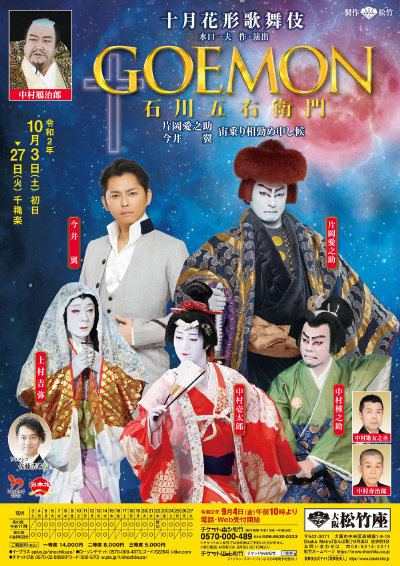 |
| Classics Tour | |
| Dates | 11 September ~ 29 October 2020 Koten he no Izanai Invitation to the Classics |
| Program |
Otokodate Hana no Yoshiwara |
| Casting | |
| Comments |
The Fall Tour of Ichikawa Ebiz˘ with performances in 13 cities, including 5 nights in Yamaga at the Yachiyoza.
|
| Nagoya (NTK Hall) |
| Dates | 11 ~ 12 October 2020 (Zenshinza K˘en) Zenshinza Performances |
| Program | |
| Casting |
Kawarazaki Kunitar˘, Arashi Yoshisabur˘, Fujikawa Yanosuke, Segawa Kikunoj˘, Tadamura Shin'ya, Yamazaki Tatsusabur˘, Anegawa Shinnosuke, Arashi Ichitar˘, Hayase Einoj˘, Nakajima K˘tar˘, Ikushima Kigor˘, Matsuura Kainosuke, Watarai Motoyuki, Motomura Yűki, Seiganji Shigemori, Niimura S˘jir˘, Fujii Isaku |
| Comments |
The production of Tsuruya Nanboku IV's masterpiece "T˘kaid˘ Yotsuya Kaidan" by the Zenshinza. It was expected to be staged in ďsaka at the National Bunraku Theatre from the 4th to the 10th of September but these performances were canceled due to the COVID-19 crisis.
|
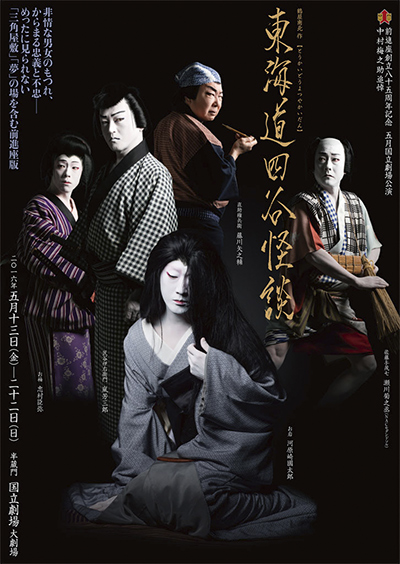 |
|
|||
| Dates | Band˘ Tamasabur˘ Eiz˘ x Buy˘ K˘en Band˘ Tamasabur˘ Image and Dance Performances |
||
| Program | |||
| Casting |
Living National Treasure Band˘ Tamasabur˘ |
||
| Comments |
A special Buy˘ program starring the amazing Living National Treasure onnagata Band˘ Tamasabur˘ in Yamaga at the Yachiyoza, a traditional wooden-built theater. There will be a mix of video projection (with video sequences coming from the high-quality Shinema Kabuki, "Cinema Kabuki") and real dancing on stage. It celebrates the 30th anniversary of Band˘ Tamasabur˘'s performances at the Yachiyoza. It was originally supposed to be staged in May 2020, then again in October 2020/November 2020, but, due to the COVID-19 crisis, it was postponed twice. |
||
|
|
| Contact | Main | Top | Updates | Actors | Plays | Playwrights | Programs | Links | FAQ | Glossary | Chronology | Illustrations | Prints | Characters | Derivatives | Theaters | Coming soon | News |